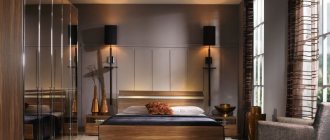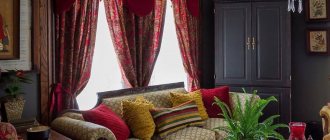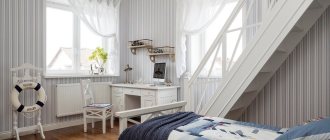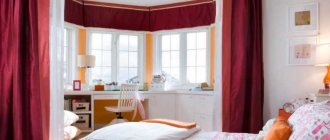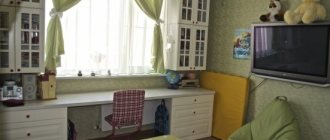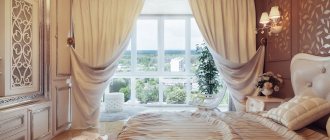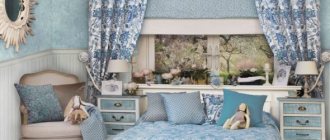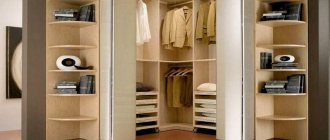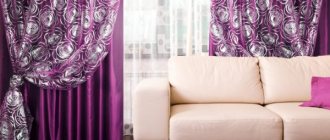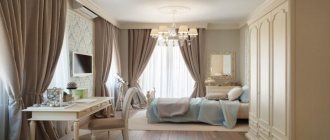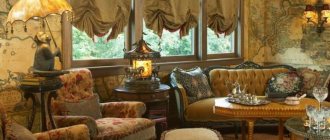Before answering the question of what types of curtains there are, let’s first consider the main elements that make up window curtains. The curtain can be either simple, consisting of one sheet, or containing a set of decorative elements. It is these elements that set the style of the curtain, which in turn sets the style of window design and affects the design of the room as a whole.
The names of the component parts - elements of curtains - will appear later when describing the types of curtains. Therefore, you need to have an idea about them. So look at the picture:
Basic elements in curtains
Lambrequin - placed at the top of the window design composition and located parallel to the floor or ceiling. The texture of lambrequins can be either straight or with folds. There can be many folds or one in the center of the lambrequin. Single folds can be rectangular, triangular or conical. You can hang the lambrequin either by the cornice or directly on the curtain fabric. The lambrequin can also be stretched over a frame made of metal, wood or plastic. This frame is fixed to the cornice. The main function of lambrequins is decorative; they complete the composition and make the curtains look more balanced and complete.
Drapes are the main element in curtains. Curtains are made from dense, usually opaque fabrics. Curtains can have double-sided decoration on both the front and back of the fabric. The back part can be a contrasting color in relation to the face of the curtain, or contain a pattern different from the front one. The main function of curtains is to protect the room - during the day from bright light from the windows, and in the evening from prying eyes from the street.
Tiebacks are usually paired elements located along the side edges of the curtain. Designed to fix curtains when open. They can also be used for draping - folding curtains and drapes. There are also single pickups. They fix the curtain to one edge.
Curtains - can be used as an additional element in the window composition or independently. Curtains are made from light transparent or translucent fabric. Since curtains allow daylight to pass through well, there is no need to open them during the daytime. Curtains closed during the day will protect the room well from onlookers outside the window. And in the evening, curtains will take on this role.
That's probably all there is to the basic elements.
And one more important point. When choosing the type of curtains, do not forget that for different curtains you will also need curtain rods corresponding to the curtains. I described in detail what kind of cornices there are in this article. Now let's figure out what types of curtains there are.
Curtains, according to the type of opening, can be divided into three main types:
- sliding,
- lifting
- stationary
Advantages and disadvantages of short curtains
Short curtains for the kitchen, living room, bedroom and other rooms in a modern interior are used with special attention. They allow you to keep the room tidy and comfortable, protect it from sunlight, and protect it from nosy neighbors.
Short curtains have the following advantages:
- In small rooms, the height is not visually reduced;
- They also do not take up much space in the room;
- Short curtains are convenient when you need free space at the window to place furniture;
- The interior style can be complemented with lambrequins, tassels and other decorative elements;
- Short curtains contribute to greater illumination of the room;
- The cost of short curtains is much lower, since the consumption of materials is much less;
- Free air circulation in the room;
- Such curtains are less dirty, because most of the dust comes from the floor;
- They are easier to wash and iron.
Among the disadvantages of short curtains and blinds, it is worth noting that they cannot be used in narrow openings, in rooms with low ceilings, or in the presence of an old radiator that needs to be hidden.
Types of sliding curtains
The sliding type of curtains involves opening the curtains to the sides of the window. As a rule, the upper part of such curtains is fixed vertically to the cornice. Sliding curtains can be adjusted in width and height.
Classic straight curtains
This type of curtains is the most widespread. Classic straight curtains consist of thick curtains and light curtains mounted vertically on a cornice. Lined curtains can be used.
Crossed curtains
The panels of this type of curtains are fixed on opposite sides of the cornice. The fabric of the curtains goes cross to cross. Such curtains can consist of either two halves or one sheet that is thrown over the cornice.
Cafe curtains
This type of curtain refers to short curtains, the length of which does not fall below the top edge of the window sill. Cafe curtains are attached to a cornice or bar located in the middle of the window. The fabric can be either dense or transparent. In addition, various decorative elements can be used - buttons, loops, eyelets, etc. The height of the cafe curtains allows light to enter the window even when closed.
Curtains with lambrequins
From the name it is clear that this type of curtains is complemented by decorative elements - lambrequins. Lambrequins can be attached directly to the curtain fabric or have independent fastening elements. Lambrequins can have both a hard and soft design. Wooden slats can be used as the basis for a rigid structure, or braid for a soft one. For curtains with lambrequins, it is optimal to use a rail curtain rod, consisting of several rows for fastening the curtains. This type of curtains is used in classic interiors.
Japanese curtains
This type of curtains has a rigid structure. The curtains are fixed to the frame. Usually the width of one canvas does not exceed 1 meter. Japanese curtains are not adjustable in height, but move along the width of the window. Such curtains are very similar to screens, which are used as light partitions in a room. The use of Japanese curtains is appropriate in Japanese-style and minimalist interiors
Thread curtains (muslin)
This type of curtain is made of heavy silky threads. Due to the weight, the threads do not get tangled. Thread curtains can also be used to decorate doors or zoning space in the interior
Photo curtains
This is a fairly new type of curtain for the Russian market. For their manufacture, dense light-proof fabrics are used, for example, blackout or satinette. For those who like to sleep in the morning, these curtains will be a good surprise. The design is applied to the fabric using digital printing. Therefore, to order, you can make almost any design you like on your curtains. In addition, manufacturers make bed linen and tablecloths with photo-printed designs, which makes it possible to tie together the composition in the interior. The curtains open to the sides like regular straight curtains.
Types of curtains in the interior
Curtains will not only protect from the sun, but will also help keep the room warm, hide imperfections in the finish, and transform the space:
- for a room in the Art Nouveau or minimalist style, it is better to take Roman or roller curtains;
- the classic interior will be complemented by thick floor-length curtains with drapery, lambrequins and tiebacks;
- in a rustic style, short, lightweight models are appropriate;
- for country, a symmetrical check pattern is suitable, for Provence - a floral print;
- Empire and Baroque styles will be decorated with textiles with gold or silver embroidery.
Types of lifting curtains
The next type of curtains combines the method of opening them. Lifting curtains open upward using special mechanisms. Lifting curtains are not adjustable in width; they have a fixed size, usually equal to the width of the window opening. Lifting curtains are also called flat, apparently because when opened, the curtain canvas moves along the plane of the window.
Austrian curtains
This type belongs to flat curtains. When raised, Austrian curtains form elegant wave-like folds. When lowered, the curtains hang straight and are slightly gathered at the bottom.
French curtains
This look is very similar to Austrian curtains. The main difference between French curtains is that they have small horizontal folds both when raised and lowered. These curtains are usually made of lightweight fabric. French curtains are adjustable only in height
Roman curtains
This type of curtains is also classified as flat curtains. They are made of thick fabric. Horizontally at equal distances, the fabric is stitched across the entire width and forms narrow horizontal pockets into which special strips are inserted.
The upper part of the Roman blind is firmly fixed to a special cornice, which is equipped with a lifting mechanism.
Roman blinds are raised using cords that are threaded into rings on the back of the curtain. When raised, the curtain forms horizontal folds.
Roman blinds are usually used in simple interiors or in the kitchen.
Some types of Roman blinds
English curtains
This type of curtain is a type of Roman blind. The main difference between English curtains and Roman curtains is their pomp. The pomp is created by the additional width of the fabric. When assembling the curtains, lush bow folds are formed.
Roller blinds
This type of curtain is a flat canvas that is assembled upward using a special mechanism. Using this mechanism, the curtain is rolled into a roll, which is hidden under the box at the top of the cornice. For lifting, a thread or chain is used, which can be either on the left or on the right side of the roller blind. The curtain lifting mechanism provides for fixing the curtain at different heights. The fabric for making roller blinds is usually quite dense. It can be either plain or with a pattern.
The advantage of roller blinds is their compactness. It does not protrude far from the window, and is often even in the frame. Such curtains will fit well into a minimalist interior.
Pleated curtains
This type of curtains came from Germany. They are often called pleated blinds. Indeed, pleated curtains look similar to horizontal blinds. But instead of the slats used in blinds, curtains use thick fabric with pleats. Pleated curtains can be used on windows with both simple and complex shapes. Fabrics for pleated curtains are treated with a protective compound that helps the fabric keep its shape and protects it from fading and dust. You can find pleated curtains made of paper.
How to choose the right curtains
So, it is quite obvious that all kinds of drapes, curtains and curtains are not independent elements. They are designed to complement and enhance the overall design concept of the interior. And they are chosen depending on the style of furnishings and furniture.
Classic style curtains consist of light tulle and heavy drapes made of thick fabric
For example, a luxurious classic interior requires voluminous draperies, decorative elements and shine. Modern stylistic trends, on the contrary, are harmoniously complemented by laconic curtain models. Well, it’s impossible to imagine country style without cute little decorative elements, rustic flowers and natural materials.
Modern interior styles use straight curtains on simple cornices.
The shape of curtains, regardless of the style of the interior, is also allowed to be different. For example, in some rooms floor-length curtains are the best solution. And in other small rooms, it is recommended to use short curtains to visually expand the space.
Short curtains look stylish and are often used in the kitchen
Also, asymmetrical curtains are suitable for correcting the room, when one curtain is wider and the other is narrower (or, one curtain is long and the other is short). As a rule, such options are used in attic rooms with non-standard windows and balconies.
Long curtains hide window imperfections well, visually raise the ceiling and expand the space
Finally, to give a special chic to the room, multi-layer models are used. They best emphasize the luxury and elegance of a classic style. And for more laconic interiors, roller curtains or Japanese panels are suitable.
Types of stationary curtains
This type of curtains is united by the impossibility of their movement. The curtain fabric is fixed on the curtain rod and does not require the curtain to move along it. Typically, stationary curtains have a decorative function and serve to decorate the interior. For example, you can use them to create the illusion of a window in a windowless room.
Italian curtains
This type of curtain is a bit like crossed curtains. The peculiarity of Italian curtains is that the curtains are fixed to the cornice without the possibility of their movement from above. To open the curtains, they are simply pulled apart and tied with tiebacks. In this case, the tiebacks or cord for tying are located closer to the top of the curtain. This technique gives the window an interesting frame line and is a “trick” of Italian curtains. Italian curtains are well suited for non-standard windows. For example, arched ones. Sometimes, to pick up curtains, a simple mechanism consisting of rings and braid is used. The mechanism is attached to the back of the curtain.
Imperial curtains
Designers consider this type of curtain to be the most difficult to implement. Imperial curtains are pompous and ceremonial. They will look good in a large room with high ceilings.
Bishop sleeve curtains
Used to make the room look grand. They are made from both light and dense fabrics. To give curtains a more expressive volume, inserts made of tissue paper or padding polyester are sometimes used.
Stained glass curtains
Because of the similarity, this type of curtain is also called hourglass. The upper and lower parts of the curtain fabric are fixed on the cornice. In the center, the curtain fabric is collected using selection. The collection may take the form of a bow. This type of curtains is good to use on small windows in galleries or summer gardens. Hourglasses are also used to decorate doors with glass.
Curtain decor, mounting methods, examples in interiors
Roman, roller and blinds are often secured using brackets. They are usually sold complete with special parts for installation.
Methods for attaching fabric curtains:
- rings - put on the bar, and the curtain is attached to a hook, clip or clothespin at the bottom of the ring;
- braid - a fabric with a sewn curtain tape at the top of the fabric, which can regulate the degree of drapery of the fabric (the curtain is strung on a rod or attached to hooks made of aluminum or plastic);
- loops - sewn at the top of the fabric, through which the cornice subsequently passes (the loops are often decorated with appliqués, distinguished: blind loops and with fasteners - Velcro, button);
- ties - at the top of the curtain there are textile ribbons with which the canvas is attached to the cornice (you can use simple knots for this or decorative ones - in the shape of a bow);
- drawstring - a special pocket for the curtain rod, used for light fabrics;
- magnets - fastening of the canvas occurs due to the fixation of magnets hanging on the base of the cornice (sometimes magnets are combined with various types of decorative clips).
Curtains with eyelets look modern and aesthetically pleasing Source markiza.kz
More often, ready-made fabric curtains are attached to the cornice using a wide ribbon with several loops. If you ask to make a product to order, you can choose the most suitable fastening and design of the curtain, based on the style of the interior:
- for long fabric with drapery in a modern interior, eyelets are suitable for fastening;
- Retro-style curtains can be hung with clips or ties;
- Magnetic clips, ropes with tassels, and jewelry tie-backs are suitable for a classic interior;
- for a children's room, they usually choose toy-shaped tie-backs;
- for the imperial style, swags, frills, bandeaus, crossovers and chill molds are used as curtain decoration;
- the curtains in the Provence room will be decorated with ruffles, textile and knitted tiebacks.
Curtains with lambrequin and tulle are hung on multi-level cornices Source stroy-podskazka.ru
Curtains for decoration
I have identified these curtains as a separate type because they do not serve to decorate windows, but to decorate other interior elements.
Curtains for doors and doorways
Curtains for doors can serve several functions
- decorative function - in this case, the curtains simply decorate the doorway and, depending on the style, can make your interior more formal or, conversely, more homely and cozy.
- the function of a partition or curtain between rooms or zones in a room. In this case, the curtain performs the function of a door - it closes the door frame and separates the rooms.
Door curtains can be attached to the cornice above the doorway or directly to the door. Attaching curtains to a door is usually used on doors with glass. An example of such fastening was presented above when describing stained glass curtains.
Canopy curtains
The word canopy comes from the Italian baldacchino, which meant “silk fabric from Baghdad.” The canopy appeared in the ancient East. Then an umbrella made of fabric was worn over the king, which protected him from the sun and prying eyes. Later, the umbrella turned into a portable throne or bed, protected by fabric around the perimeter. In rooms, the canopy was used as a curtain over a throne or a ceremonial seat. Later the canopy found itself in the bedroom. In Rus', our ancestors used a canopy to protect a baby's sleeping place from drafts and insects - hanging the fabric over the baby's cradle.
Currently, canopies are mainly used in bedrooms. The fabric is hung on special structures - or columns around the bed, as well as on a cornice attached to the ceiling above the bed. Canopy curtains will add comfort to your sleeping nest and, if necessary, protection from prying eyes.
Which cornice is better
In addition to the characteristics of the fabric, you need to pay attention to the cornice. The design should suit the curtain and the interior of the room.
Main varieties:
- Among wooden representatives, the most popular option is the classic rod; there is also a more expensive model with a massive strip on the front side and decorative carvings. Suitable for a country house made of timber or for a room in eco, country, Provence, minimalism styles. The color of the cornice can be any: from white to black. Dark ones are ideal for classic, empire and baroque.
- Forged - due to the large number of varieties, metal structures are used in the design of any modern interior. Particularly popular in loft and hi-tech styles. The cornices have an interesting decor: corner connectors, plugs, tips. Possible colors: bronze, bleached gold, copper, stainless steel, onyx, black, satin.
- Plastic structures can imitate a wooden cornice. The base is made of a thin sheet of metal and is covered with a film reminiscent of the texture of wood. The remaining components are made of plastic.
- There are models for installation in a ceiling niche, equipped with a special groove for fixing a decorative tape that will hide rollers and hooks for curtains. The main advantage of plastic models is their low price.
- Strings - used for light curtains. Classification depending on the material: strong threads, stainless steel, polymers, metal cables. Techno, hi-tech, country, Provence, and minimalism styles will look harmonious in a room. The string design is almost invisible and is often used in small spaces.
The color of the cornice depends on the decoration of the walls and the type of curtain. For a small space, it is better to choose light, laconic models that will not attract attention.
A few more tips:
- a dark cornice looks beautiful in combination with light curtains, or you can choose tones that are close to each other;
- the cornice holders should blend into the color scheme of the room; often a shade similar to the wall decoration or identical to the base of the cornice is chosen;
- to create maximum privacy and good protection from the sun, a two-tier cornice, which is equipped with a rounded track or strip, will help;
- The cornice must match the density and size of the curtains; you should not hang light curtains on massive structures.
Installation of the curtain rod depends on the type of curtains. Installation methods: on the wall, ceiling, window opening. A curtain attached to the ceiling will visually increase the height of the room. Roman, roller and blinds can be installed on the window sash.
Roller blinds differ from Roman models in their smooth fabric, regardless of the position of the curtain Source www.ivd.ru
